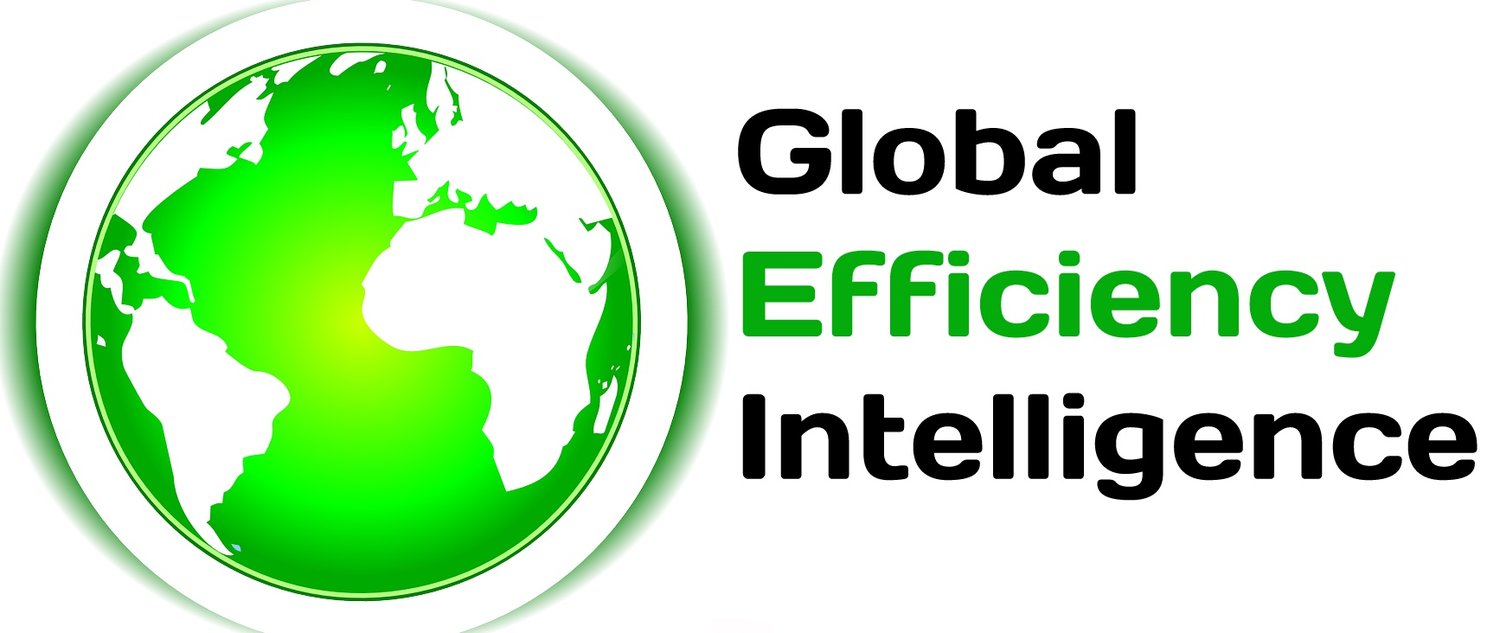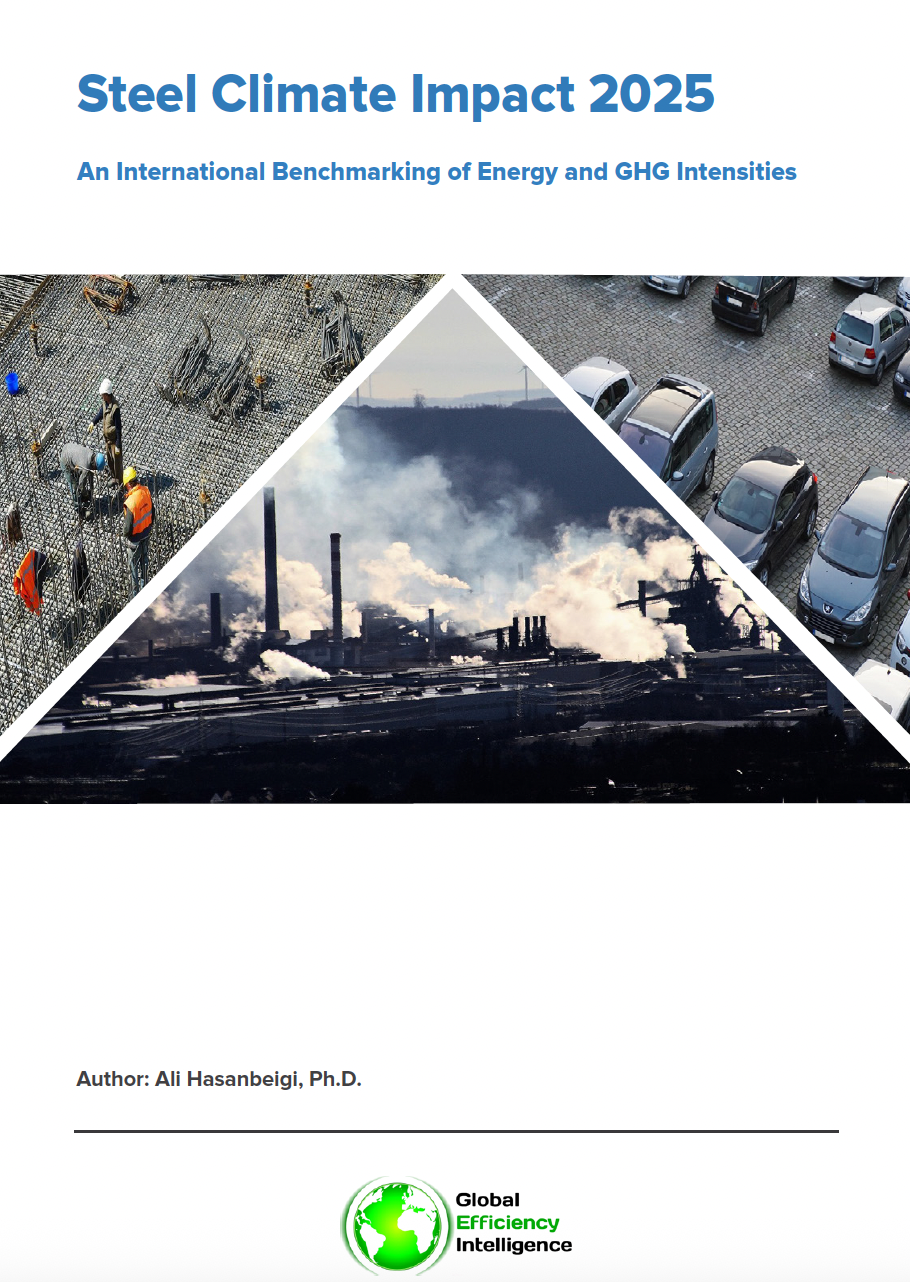Steel Climate Impact 2025
An International Benchmarking of Energy and GHG Intensities
Author: Ali Hasanbeigi, Ph.D.
The global iron and steel industry is one of the most energy-intensive sectors and a central focus of climate policy. It accounts for about 11% of global CO₂ emissions and over 8% of total greenhouse gas (GHG) emissions, making it the largest single industrial source of emissions worldwide. Its annual GHG footprint exceeds that of nearly every country except China and the United States. This scale of impact underscores the importance of benchmarking national steel industries to identify structural drivers of emissions and highlight opportunities for deep decarbonization.
In 2023, the global steel industry emitted about 4.43 Gt CO₂e, with CO₂ emissions from fuel/reductant and electricity use making up 82% and methane from coal mining contributing the rest on a GWP20 basis. Blast furnace-basic oxygen furnace (BF-BOF) production dominated, accounting for nearly 3.9 Gt CO₂e, while the electric arc furnace (EAF) route emitted around 0.53 Gt CO₂e globally (Figure ES1). Fuel-related emissions remain the main driver across all routes, especially in BF-BOF steelmaking, reflecting the industry’s heavy reliance on coal. Emissions are also highly concentrated geographically: China alone produced about 60% of global steel GHG emissions, followed by India, Japan, Russia, and South Korea. These five countries alone account for around 80% of global steel GHG emissions. This concentration highlights the outsized role of a few major producers in determining the sector’s global climate impact.
In this study, we benchmarked the energy and GHG intensity of steel production in the largest steel-producing countries/region. Rather than relying on a single intensity figure for each country, the analysis distinguished between the BF-BOF route and the EAF route. This distinction is crucial, as the two technologies differ fundamentally in feedstock, energy requirements, and emissions intensity. The results show large differences across countries, which can be traced to variations in industry structure, fuel and electricity emissions factors, feedstock choices, and other factors.
At the level of the entire steel industry, Italy, Mexico, the United States, and Türkiye have the lowest steel industry CO₂ intensities (below 1.2 t CO₂e/t crude steel), driven by very high shares of scrap-based EAF production and, in the case of the U.S. and Italy, a higher use of natural gas instead of coal. Canada and the EU-27 also perform relatively well, with intensities around 1.4 t CO₂e/t crude steel, reflecting moderate to high EAF shares. By contrast, China and India are the most carbon-intensive producers, due to their heavy reliance on BF-BOF and the use of pig iron/hot metal in EAFs in China and large share of coal-based DRI in EAFs and induction furnaces in India (Figure ES2). Overall, differences in share of EAF steelmaking, fuel mix, electricity emissions factors, and EAF feedstock use explain much of the variation across countries.
When comparing within a given production route, further differences emerge. Canada records the lowest BF-BOF CO₂ intensity at 2.0 t CO₂e/t crude steel, with Germany, Italy, and the EU-27 close behind at 2.2, and the U.S., South Korea, and Mexico around 2.3, reflecting higher efficiency and greater reliance on lower-carbon fuels and electricity (Figure ES3). At the other end, India, Russia, China, and Vietnam show the highest intensities, driven by coal-dominated fuel and power mixes, and high methane emissions from coal mining, particularly for Russian coal that is used in Russia, China, and India.
The benchmarking of EAF steelmaking shows large variation across countries, with the EU, Brazil, and Canada recording the lowest intensities due to their reliance on scrap-based EAFs and lower-carbon electricity supply (Figure ES4). By contrast, India and China stand out with the highest values, while most other countries fall below 0.7. India’s exceptionally high EAF intensity reflects its heavy reliance on coal-based DRI as EAF feedstock, which is far more carbon-intensive than scrap. Mexico also shows higher-than-average values because 44% of its EAF feedstock is natural gas-based DRI (NG-DRI), and China’s reliance on pig iron/hot metal (around 25% of EAF inputs) raises its EAF carbon footprint significantly. Russia’s higher emissions stem from NG-DRI use, while Vietnam and Poland have a very carbon-intensive electricity supply.
While scrap-based EAFs have lower carbon intensity, scrap supply is limited and cannot meet all future steel demand. Some primary production using DRI-EAF will remain essential, especially in growing economies. In such cases, higher DRI use may temporarily raise the national carbon intensity of EAF production but represents an important structural shift away from coal-based BF-BOF steelmaking toward cleaner DRI-EAF pathways, including hydrogen-based DRI in the future.
National differences in steel industry emissions are shaped by a combination of structural and operational factors rather than technology share alone. Key drivers include the type of feedstock used in EAFs, with scrap lowering emissions while reliance on pig iron or DRI raises them; the fuel mix, where natural gas use results in lower BF-BOF intensity compared to coal dependence; and the carbon intensity of electricity supply, which is particularly important for EAF-heavy production and is further affected by captive fossil-fuel power generation. Technology penetration and plant age also matter, as seen in China’s efficiency gains. Additional factors such as product mix, capacity utilization, regulatory frameworks, and energy and raw material costs further explain cross-country variation.
The study also highlights the importance of scrap availability. Countries with abundant high-quality scrap (e.g., the U.S., Italy, and Türkiye) are structurally advantaged, while those with limited scrap supply (e.g. China and India) face higher barriers to decarbonization, underscoring the need to decarbonize the iron production. Similarly, countries with clean electricity grids gain a major advantage in the transition to electrified steelmaking.
Because the top five emitting countries (China, India, Japan, Russia, and South Korea) account for about 80% of the global steel industry’s GHG emissions, their actions will determine the global trajectory. Coordinated policies, technology investments, and trade rules in these countries will be decisive for the steel industry’s ability to meet the Paris Agreement targets.
Global steel demand will continue to grow with urbanization, infrastructure expansion, and the energy transition, making transformative technologies essential for deep emissions cuts. Incremental gains such as efficiency improvements and fuel switching are valuable but insufficient to deliver net zero by 2050. Achieving deep decarbonization will require clear policy signals and major investment to scale up green H₂-DRI, expand renewable power and electrification, higher scrap use, material efficiency, and steel demand management, and roll out CCUS for young BF-BOF plants that are unlikely to be phased out in the near/medium term. Stronger international cooperation on green iron trade is also critical. Without decisive policy action and financing, the steel sector cannot align with global climate targets.
To read the full report and see the complete results and analysis of this new study, download the full report from the link above.
Interested in data and decarbonization studies on the global steel industry? Check out our list of steel industry publications on this page.
Don't forget to follow us on LinkedIn and X to get the latest about our new blog posts, projects, and publications.





